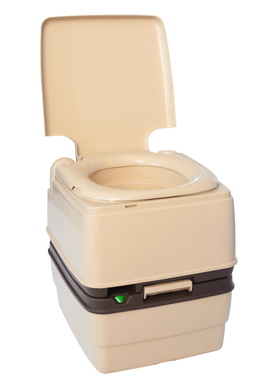In a self-contained composting toilet, the toilet seat and the composting reactor are configured under one unit. Read on to understand more about them.

In scientific terms, a composting toilet can be considered as an aerobic treatment system, which is designed in such a way that human excreta is decomposed through aerobic break down or composting. The byproducts of composting toilets are used as fertile compost. The composting toilet systems require little or no water for operation. Hence, they are most preferable in areas where there is less availability of water for flushing the toilets.
Generally, there are two types of composting toilet systems based on the configuration, namely, centralized or remote type and self-contained type. In the former case, the composting reactor is not built along with the toilet seat, rather it is situated away from the toilet seat. On the contrary, in a self-contained composting toilet system, the toilet seat and composting reactor are placed as one unit.
The main purpose of a self-contained composting toilet is to reduce leakage of organic nutrients (from the human excreta) to nearby water sources and minimize the spread of disease-causing pathogens to the inhabitants of the area. Similar to other composting toilets, a self-contained composting toilet system also helps in converting human excreta into valuable byproducts.
In comparison to the regular flush toilet type, a self-contained composting toilet is slightly larger in size. Nevertheless, it occupies nearly the same space as that of regular toilets. While speaking about the configuration of a self-contained toilet system, the composting reactor is situated in continuation to the receiving end. Hence, breakdown of the excreta by the aerobic microbes starts directly, which is not so in case of a remote type.
For initial operation, most of the manufacturers recommend an introduction of bacterial cultures in the composting reactors. Once, composting has started, there is no need for recurrent inoculation of bacteria inside the unit. In some of the composting toilets, heating systems are installed to create optimum temperature for nutrient breakdown by the microbes. Heating element also helps in evaporation of moisture and urine that are accumulated in the composting reactor.
In order to enhance the decomposition process in a self-contained composting toilet, there are certain added features, which may include ventilation pipe for exhausting carbon dioxide or other gases and fans for providing increased aeration. With the added features, non-usable gases are expelled while enhancing oxygen filtration for speeding up aerobic decomposition.
At times, bulking agents in the form of absorbent carbon, are added in the self-contained composting toilet to provide an increased surface area for microbes and also to absorb urine and reduce odor. If installed and operated properly, such a toilet smells lesser than the regular toilet systems. One can follow the manufacturer's guidelines for alleviating obnoxious smells.
A self-contained composting toilet system can be operated as a single-chamber or a batch wise system. In the former type, human excreta is added in a chamber and the end product is removed continuously, whereas in batch-wise type, excreta is added in one chamber, cured and passed to another chamber for removal. In the meantime, the first chamber is fed with excreta, thus operating in a batch wise manner.
There are several advantages of these toilets. To mention a few, the aerobic decomposition that undergoes in such toilet systems is much quicker than that of anaerobic breakdown in waste-water treatment plans. Also, it serves as a major tool for recycling nutrients into the environment. If you are planning to install a self-contained composting toilet, you can either opt for the ready-made type or site-built type.






 In scientific terms, a composting toilet can be considered as an aerobic treatment system, which is designed in such a way that human excreta is decomposed through aerobic break down or composting. The byproducts of composting toilets are used as fertile compost. The composting toilet systems require little or no water for operation. Hence, they are most preferable in areas where there is less availability of water for flushing the toilets.
In scientific terms, a composting toilet can be considered as an aerobic treatment system, which is designed in such a way that human excreta is decomposed through aerobic break down or composting. The byproducts of composting toilets are used as fertile compost. The composting toilet systems require little or no water for operation. Hence, they are most preferable in areas where there is less availability of water for flushing the toilets.